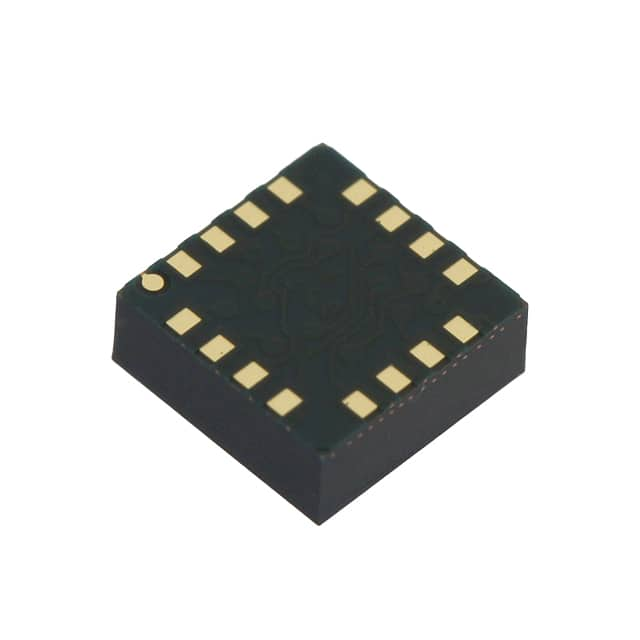Xem thông số kỹ thuật để biết chi tiết sản phẩm.

LIS331DLHTR
Product Overview
The LIS331DLHTR belongs to the category of three-axis digital accelerometers. It is commonly used in various electronic devices for motion sensing and orientation detection. The characteristics of this product include its small size, low power consumption, and high accuracy. The package consists of a small surface-mount module with essential components integrated onto a single chip. The essence of the LIS331DLHTR lies in its ability to provide precise acceleration measurements in a compact form factor. It is typically available in reels containing a specific quantity per reel.
Specifications
- Operating Voltage: 2.16V to 3.6V
- Sensitivity: ±2g/±4g/±8g
- Output Data Rate: 0.5 Hz to 1 kHz
- Digital Output: I2C/SPI
- Temperature Range: -40°C to +85°C
- Package: 16-lead LGA
Detailed Pin Configuration
The LIS331DLHTR features a 16-pin configuration, including power supply pins, communication interface pins, and output pins. The pinout is as follows: 1. VDD (Power Supply) 2. GND (Ground) 3. SCL/SDI (Serial Clock/Data Input) 4. SDA/SDO (Serial Data Output) 5. CS (Chip Select) 6. INT1 (Interrupt 1) 7. INT2 (Interrupt 2) 8. SA0/ADR (Address Selection/Input)
Functional Features
The functional features of the LIS331DLHTR include high-resolution digital output, low noise, and embedded self-test capabilities. It also offers programmable interrupt generators for free-fall, motion detection, and pulse detection.
Advantages and Disadvantages
Advantages
- Small form factor
- Low power consumption
- High accuracy
- Programmable interrupt generators
Disadvantages
- Limited sensitivity range compared to some alternative models
- Restricted temperature range
Working Principles
The LIS331DLHTR operates based on the principles of micro-electromechanical systems (MEMS) technology. It utilizes capacitive sensing elements to measure acceleration along three orthogonal axes. The measured capacitance changes are converted into digital signals and processed to provide accurate acceleration data.
Detailed Application Field Plans
The LIS331DLHTR finds applications in various fields such as: - Consumer electronics (e.g., smartphones, tablets, gaming devices) - Industrial equipment monitoring - Automotive safety systems - Wearable devices - Robotics and drones
Detailed and Complete Alternative Models
Some alternative models to the LIS331DLHTR include: - ADXL345 from Analog Devices - MMA8452Q from NXP Semiconductors - KX022-1020 from Kionix
In conclusion, the LIS331DLHTR is a versatile three-axis digital accelerometer that offers high accuracy and low power consumption, making it suitable for a wide range of applications across different industries.
Word Count: 411
Liệt kê 10 câu hỏi và câu trả lời thường gặp liên quan đến ứng dụng LIS331DLHTR trong giải pháp kỹ thuật
What is the LIS331DLHTR accelerometer used for?
- The LIS331DLHTR accelerometer is commonly used to measure acceleration in various technical solutions, such as motion detection, tilt sensing, and vibration monitoring.
What is the operating voltage range of the LIS331DLHTR?
- The operating voltage range of the LIS331DLHTR is typically between 2.16V and 3.6V.
How does the LIS331DLHTR communicate with a microcontroller?
- The LIS331DLHTR communicates with a microcontroller using an I2C or SPI interface.
What is the measurement range of the LIS331DLHTR?
- The LIS331DLHTR has a selectable measurement range, commonly ±2g, ±4g, or ±8g, allowing it to measure accelerations within these ranges.
Can the LIS331DLHTR be used for impact detection?
- Yes, the LIS331DLHTR can be used for impact detection due to its ability to accurately measure sudden changes in acceleration.
What are the typical applications of the LIS331DLHTR in automotive systems?
- In automotive systems, the LIS331DLHTR can be used for airbag deployment, electronic stability control, and rollover detection.
Is the LIS331DLHTR suitable for industrial machinery monitoring?
- Yes, the LIS331DLHTR is suitable for industrial machinery monitoring, including vibration analysis and condition monitoring.
What are the key features of the LIS331DLHTR that make it suitable for wearable devices?
- The small form factor, low power consumption, and high accuracy of the LIS331DLHTR make it suitable for integration into wearable devices for activity tracking and gesture recognition.
Can the LIS331DLHTR be used in drone stabilization systems?
- Yes, the LIS331DLHTR can be used in drone stabilization systems to sense changes in orientation and movement, aiding in flight stability.
What are the temperature operating limits of the LIS331DLHTR?
- The LIS331DLHTR typically operates within a temperature range of -40°C to 85°C, making it suitable for a wide range of environments and applications.

